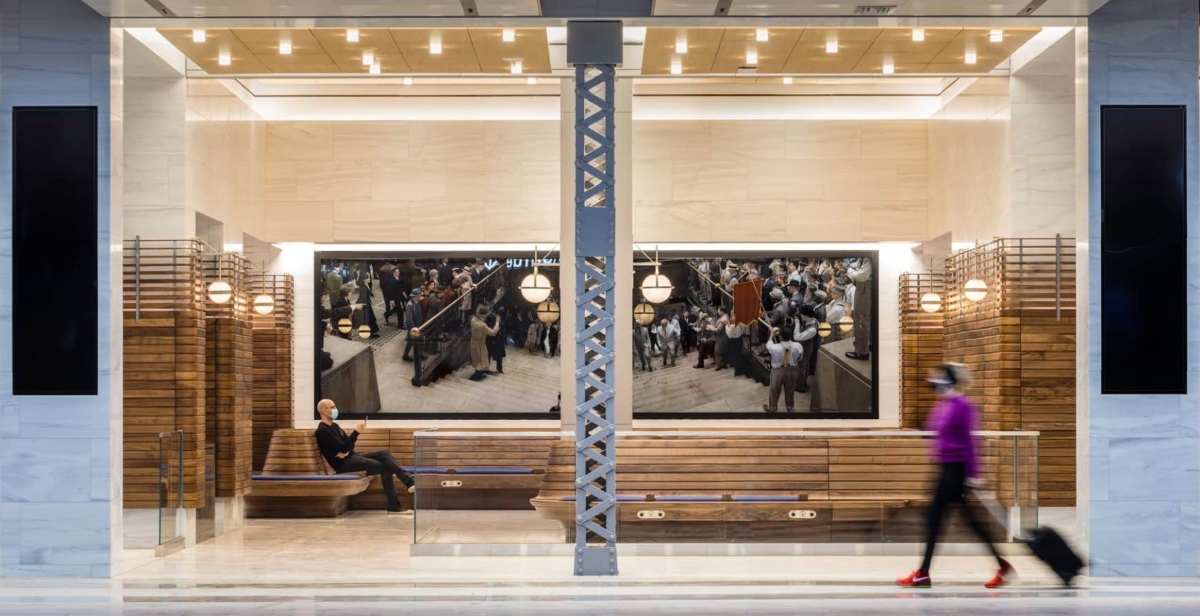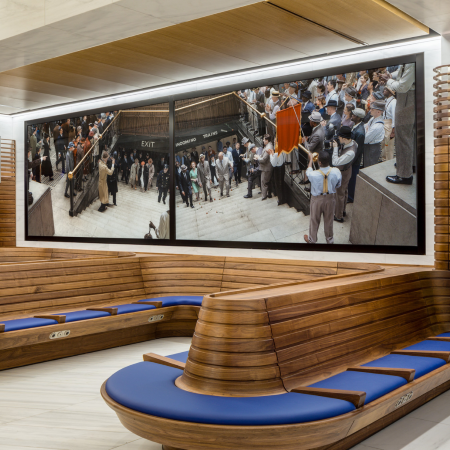Glass as a Canvas
The role of architectural glass in public art

Public art enhances the identity of communities, sparks conversation, and invites public engagement with the built environment. While sculptures and murals often come to mind, architectural glass has emerged as a compelling medium for public art—especially as advancements in fabrication and printing technology expand creative possibilities. For glass fabricators and glazing contractors, public art presents an opportunity to apply their expertise in unique and meaningful ways.
What is public art?
Public art is defined by its accessibility and placement within shared spaces—whether installed in transit stations, on building façades, or integrated into railing systems and architectural cladding. Unlike gallery-bound artwork, these installations become part of the surrounding structure, blending utility with expression. Architects and artists increasingly turn to glass for its versatility, transparency, and durability as they seek new ways to tell stories and activate space.
Glass as a medium for artistic expression

Architectural glass provides artists and designers with a rich medium for experimentation. It allows interplay between light, transparency, and reflection—qualities that change throughout the day and seasons. Its ability to be fabricated in custom sizes, finishes, and configurations makes it particularly suitable for large-scale public applications.
For example, the Moynihan Train Hall in New York City features a public art installation by artist Stan Douglas, using direct-to-glass ceramic frit printing to embed photographic images onto oversized low-iron glass panels. These works are permanent, UV-resistant, and durable for high-traffic transit spaces.
At the Museum at Prairiefire in Kansas, dichroic glass creates a dynamic façade that reflects shifting colors throughout the day—an effect designed to evoke the motion and light of prairie fires. This project demonstrates how specialty glass can merge architectural function with symbolic storytelling.
Types of architectural glass in public art
Several types of decorative and architectural glass are commonly used in public art projects:
- Digitally printed glass. This method uses ceramic frit ink fused into the glass surface during tempering to produce vibrant, fade-resistant digital imaging—ideal for safety glazing applications.
- Dichroic glass. Creates a shifting iridescent effect based on light and viewing angle.
- Laminated glass with decorative interlayers. Allows for printed films, textiles, or color layers embedded between two sheets of glass, adding safety and aesthetics.
- Etched and engraved glass. Offers tactile textures and custom detail through sandblasting or laser techniques.
- Fused and cast glass. Often used for feature walls or integrated sculptural elements.
- Stained glass. Still relevant in civic buildings or commemorative installations with symbolic themes.
Each form allows for creative expression while meeting performance standards required in architectural environments.
The role of glass fabricators and glazing contractors

The successful integration of public art into architectural settings relies heavily on the expertise of the glass and glazing industry. While artists may envision bold patterns or layered imagery, it is the glass fabricators who translate these creative concepts into building-compliant, structurally sound glass elements. From precise sizing and tempering to decorative printing and interlayer selection, fabricators ensure that each installation not only reflects the artistic vision but also meets the performance and safety requirements of the built environment.
Glazing contractors, in turn, play a crucial role in installation. Whether the glass is integrated into curtain walls, rain screens, railing systems, or interior cladding, glazing professionals ensure the artwork is securely and accurately installed. For instance, the MBTA Lechmere Station in Massachusetts incorporated a public art display utilizing digitally printed glass panels in the elevator tower. The train station artwork is both functional and artistic.
A collaborative process with lasting impact
Public art projects are typically developed through partnerships among artists, architects, engineers, municipalities, and construction teams. Funding may come from city grants, public art ordinances, private donors, or development incentives. Regardless of the source, successful outcomes require collaboration and technical knowledge.
For the glass industry, these projects represent more than fabrication or installation—they are opportunities to create lasting visual legacies in public spaces. With every public-facing project, fabricators and glazing contractors help define the character of a community.
Public art as a business opportunity
Architectural glass uniquely suits public art, offering transparency, vibrancy, and creative flexibility. For fabricators and glazing professionals, these projects invite meaningful participation in placemaking, storytelling, and civic identity. As cities continue to invest in public art, the glass and glazing industry is positioned to help bring visions to life—transforming architectural glass applications into community landmarks that endure for generations.


